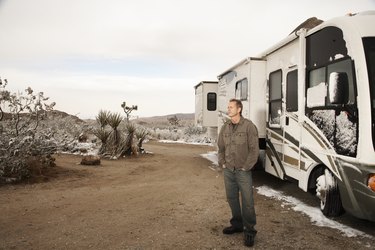
When most of us think about flat-screen TV temperatures, we worry about them becoming overheated by not being placed in a properly ventilated area. For some, it's more important to think about how cold temperatures can negatively affect the televisions. If you own an RV that you park during the winter or a summer lake house, you might have TVs that are subject to below-freezing temperatures when not in use. Cold temperatures can ruin your flat-screen televisions, but there are options to help you keep them warm.
Why Is Cold a Problem?
Video of the Day
The freezing temperatures aren't necessarily the problem with flat-screen TVs. The bigger problem is condensation that occurs when the TV begins to thaw. If it's thawed too quickly, rapid condensation can leak into the electronics and short out the components. Even gentle thawing can lead to electronic damage inside the TV. If the environment surrounding your TV ever falls below freezing, move your TV inside a warm environment for at least 24 hours before turning it on to ensure any condensation is gone.
Video of the Day
Minimum Warranty Temperatures
Check your user manual for the minimum temperature your manufacturer requires. Most will only provide warranty service for flat-screen TVs that have never been subjected to temperatures below 40 degrees F.
Minimum Operating Temperatures
If you're not concerned about voiding your warranty, you should be able to use a well-thawed TV that has been exposed to temperatures falling to zero degrees. Some can handle colder temperatures, up to -20 degrees F, so shop around with different manufacturers if you need a cold-weather rated unit. They may not warrant the product, but it should continue to operate if warmed correctly before use.
How to Keep It Warm
The best idea is to never let your TV, with its delicate electronic components, fall below the manufacturer's recommended, warranted temperature. If the TV is in an RV that you won't be using for the winter, search for heated storage facilities for your RV or remove the TV and store it in your heated house for the season. For summer vacation homes that aren't heated in the winter, remove the TV or consider leaving the heat on low for the season -- it only has to stay above 40 degrees F for most TVs. If the TV is in your unheated garage, consider adding insulation and a heating duct that can keep your garage above 40 degrees. Alternatively, attach the TV to a rolling TV stand that you can roll into the heated house when it's not in use.